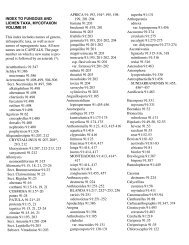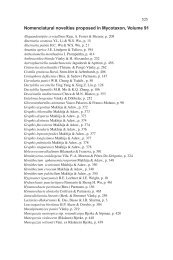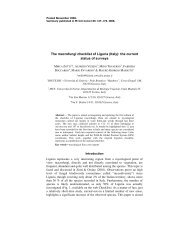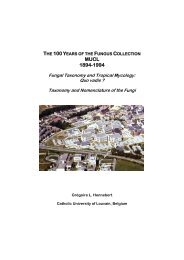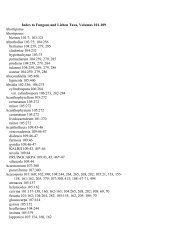download full review [pdf] - Mycotaxon
download full review [pdf] - Mycotaxon
download full review [pdf] - Mycotaxon
Create successful ePaper yourself
Turn your PDF publications into a flip-book with our unique Google optimized e-Paper software.
<strong>Mycotaxon</strong> 110 Book Reviews ... 511<br />
preparing editions of this work. However, as Geoffrey Ainsworth remarked to<br />
me when the 1983 edition appeared, we had cleaned up many former errors but<br />
also introduced new ones. As first commented in the 1995 edition (not the 2001<br />
one as stated in the Preface!), it will continue to be “a marvelously imperfect<br />
work needed by all”. But having reached its 65th, should the Dictionary now<br />
be “retired”? In the Preface the editors proclaim that this “may well be the last<br />
‘ink-on-paper’ version” but also note that any next edition would be produced<br />
after the current editors have all retired from <strong>full</strong>-time employment. While I<br />
personally find hard-copy books quicker to search for information than online<br />
databases and would be very sad if this were the last one for the Dictionary,<br />
it is the availability of compilers more than the information delivery method<br />
that I see as the greater problem. Even as the proofs were arriving, the scanning<br />
of incoming world literature and making notes and corrections for the next<br />
edition commenced used to be the normal practice at the Institute – plans for<br />
at least the data capture aspect for any possible eleventh edition need to be put<br />
into place now, if this has not been done already. If not, mycology will be in<br />
danger of losing its Bible.<br />
Schimmelpilze und deren Bestimmung. By Liliane E. Petrini & Orlando<br />
Petrini. 2008. 2nd edn. J. Cramer in der Gebrüder Borntraeger Verlagsbuchhandlung,<br />
Johannesstrasse 3A, D-70176 Stuttgart, Germany . Pp. vii +<br />
147, figs 28, tables 9. [Bibliotheca Mycologica no. 204.] ISBN 978-3-443-59106-9.<br />
Price 38 €.<br />
The first edition of this introduction to the identification of mould genera<br />
was issued in 2002 (see <strong>Mycotaxon</strong> 86: 480–481, 2003) where the <strong>review</strong>er<br />
commented that “the main potential . . . clearly lies in the fact that it is written<br />
in German.” This is also true for this new edition, in which very little has been<br />
changed. The overall length and all but a handful of pages are identical, and,<br />
remarkably, even the price is the same. The only significant change appears to<br />
be a modification of the key on p. 52 to include an extra couplet to separate<br />
Monascus and Xeromyces anamorphs from Trichothecium, which has a knockon<br />
effect in the numbering of couplets that continues to p. 56. The latest reference<br />
in the “Literatur” is from 2002; however I did find a “Gams 2006” and “Samson<br />
et al. 2004” cited in the text (p. 99) but these were not added to “Literatur”. It is<br />
most unfortunate that the chance was not taken to update the classification and<br />
to see “Deuteromycetes” perpetuated as a main heading, correct typographical<br />
errors from the first printing, and to use uncorrected author citations: for<br />
example, Aspergillus should be attributed to “P. Micheli ex Link” not “Mich.<br />
: Fr.”, Rhizopus to “Ehrenb.” not “Ehrenb. ex Corda”, and Thamidium to “Link”<br />
not “Link ex Wallr.” Sadly, such errors are likely to be perpetuated – when (in<br />
my view) they would have been better omitted throughout, as this is not a


![download full review [pdf] - Mycotaxon](https://img.yumpu.com/5381692/3/500x640/download-full-review-pdf-mycotaxon.jpg)
